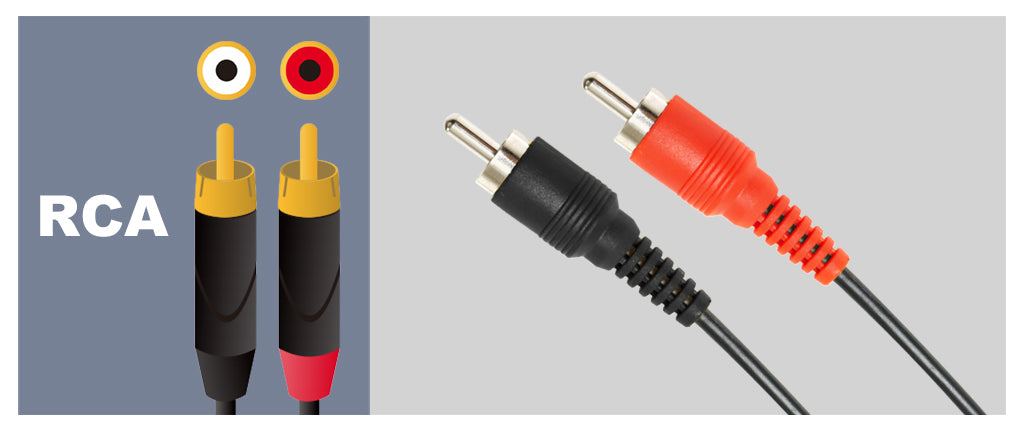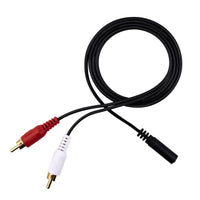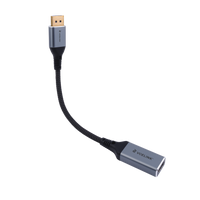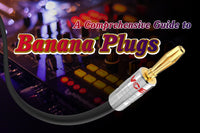Bluetooth has become a common technology for audio equipment, and it may be enough for our daily life. But Bluetooth is not powerful for instruments and can be linked with latency. To enjoy high-quality audio and great sound system at home, you probably need to work with different types of audio cable types. Read on for an easy guide.
Analog vs. Digital Audio
There are usually two types of audio cables that you can find in the studio: analog and digital audio. We’ll explain the differences between them to make you understand more.
- Analog Audio: Analog cables use a continuous electrical signal to transmit information from point A to point B. The audio quality may be affected by the analog signals, but most devices in your music studio can be analog cables. Analog cables can also be divided into balanced and unbalanced audios.

- Digital Audio: Digital cables operate by transmitting data from point A to B using a sequence of binary digits (1s and 0s). Typical audio cables are MIDI, S/PDIF, and USB cables.

Balanced vs. Unbalanced Audio
Before getting down to audio cable types, you need to know “balance.” Balance can affect the audio you hear. Analog cables can be divided into unbalanced and balanced cables. The main difference between balanced and unbalanced cables is the capability of removing noise.
Unbalanced and balanced cables feature different constructions. The former has a positive polarity wire and a ground wire, while the latter features a positive and negative polarity and a ground wire. It’s the pair of polarity wires that make the balanced cables resistant to noise. The positive and negative conductor wires work together to reduce the noise and cancel out exterior electrical interference.
If you want to have the most balanced and professional audio setup, you should not only use balanced audio cables but also balanced equipment.
Audio Cable / Audio Connector Types
Now that you know about audio techniques, it’s time to dive into audio cable types. There are various audio cables and connectors for different audio requirements.
Analog Audio Cable
TRS Cable / TRS Connector

TRS cables are easy to recognize and quite common in our daily life. The TRS connector is composed of three parts separated by two black stripes: Tip, Ring, and Sleeve. TRS cables are balanced in most cases, and they can be used for both balanced mono signals and unbalanced stereo signals.
TRS connectors are available in different sizes, including 1/4-inch (6.5mm), standard 1/8-inch (3.5mm), and 1/16-inch (2.5mm). They can be used for stereo audio connections such as headphones, microphones, and musical instruments. TRS cables can also be used for professional audio equipment, including audio mixers and interfaces.
TS Cable / TS Connector

TS (Tip-Sleeve) cables are very similar to TRS cables from the appearance, but they are easy to distinguish as the TS connector is only composed of a tip and sleeve. TS cables are always unbalanced and they are used for mono audio equipment. They can be connected to instruments such as guitars, keyboards, and other audio gear with unbalanced outputs to amplifiers or mixers. So TS cables can also be called as instrument cables. These cables can also be found in extended lengths, making them suitable for stage performances. TS cables are mostly available in standard 1/4-inch (6.5mm) sizes.
RCA Cable / RCA Connector

An RCA cable is an analog audio and video cable. RCA means Radio Corporation of America, which introduced the connector in the 1930s. Like TS cables, RCA cables only feature two wires, making them unbalanced. So you’d better use them as short as possible to avoid signal degradation. It is usually color-coded. The yellow RCA connector is generally used for composite videos, the white/black one is used for the left channel of stereo audio, and the red one is designed for the right audio channel.
RCA cables are unbalanced and often used in audio and video components such as DVD players, game consoles, or other display devices. You can often find them in home A/V systems. In addition, RCA cables are also found in DJ setups and some professional audio and video equipment.
You can use a pair of RCA to RCA cables for most devices, but if your devices are not compatible, you can also use RCA connectors with other types of connectors. For example, there are 3.5mm to RCA cables.
XLR Cable / XLR Connector

XLR cables can be named as mic cables, derived from the Cannon X series of connectors invented by James H. Cannon. These cables can be considered the most durable and standard audio cables and they are very prevalent in the audio world. XLR connectors can have 7 or more pins, but 3-pin XLR connectors are the most common in people’s daily life.
The locking design makes the XLR cable a popular choice because of preventing accidental disconnection during usage, which is very suitable for live performances on stage. There are female and male XLR connectors. The former is often found on the output of a microphone, instrument, or other audio equipment; while the latter is used for the input of a mixer to receive signals.
XLR cables are always balanced, meaning they can be long without any signal interference. So XLR cables are also suitable for live performances and professional recording studios. In general, XLR cables are compatible with many old or new devices, including microphones, PA systems, and specific instruments.
Speaker Cable / Banana Plug

Another popular audio cable is the speaker cable with a banana plug. Banana plugs look very similar to TS and TRS connectors but feature different constructions. Banana plugs are preferred to be used in home audio setups rather than in professional audio studios. These plugs are usually paired with banana plug wall plates to hide speaker cables behind TVs or A/V systems, making your room neat and beautiful.
Digital Audio Cable
MIDI Cable

The full name of the MIDI cable is Musical Instrument Digital Interface cable, which features a five-pin MIDI connector. MIDI cable is a type of audio cable that still plays a vital role in synthesizers, instruments, and other electronic devices. For example, it is often used to transmit musical data for keyboards, synthesizers, drum machines, and computers.
USB Cable

USB (Universal Serial Bus) was released as an industry standard for transmitting data between different devices. USB cables can be the most well-known digital audio cables in the world and are widely used for transferring digital audio data between computers and other devices such as audio interfaces and synthesizers. USB cables are popular among people for their high-speed and stable data transmission. But it should be noted that USB cables may not be compatible with old instruments and other audio equipment.
S/PDIF Cable

S/PDIF cable, or Sony/Phillips Digital Interface Cable, is available in optical and coaxial forms. The optical form uses fiber optic cable and TOSLINK or mini-TOSLINK connector, while the coaxial form uses coaxial cable and RCA connector. S/PDIF cables have been gradually replaced by HDMI cables, but they are still used in home theater systems, game consoles, set-top boxes, or other entertainment devices.
3 Things to Consider When Choosing Audio Cables
Length
Audio cables come in various lengths, ranging from several inches to feet. Cable length does matter for sound quality especially when you buy unbalanced audio cables. It’s known that longer audio cables can cause signal degradation and affect audio quality.
Of course, different lengths of audio cables are chosen by various scenarios. For example, a long audio cable is necessary for live performance to connect your instruments to the mixer or PA system. But a short audio cable is more suitable for recording studios to avoid noise.
Audio Level
Before choosing audio cables, you need to learn the following four types of audio level ratings.
- Mic Level: This is the weakest audio signal level. It would help to have a preamp to boost it to a standard line level. Otherwise, your microphone audio will be too quiet to be heard.
- Instrument Level: This is a stronger signal level than the mic level, often used for instruments like guitars, basses, keyboards, and synthesizers. Instrument-level signals can match the line-level device by using DI boxes.
- Line Level: It is regarded as the standard audio signal level used for most audio devices.
- Speaker Level: This is the strongest audio signal level, and it can create a sound wave that people can directly hear.

Quality
Choosing a high-quality audio cable can help reduce exterior noise and interference. Noise-free signal transmission is essential for audio mixing and recording. So, how to identify the quality of an audio cable? Always choose those with flexible and durable cables. Gold-plated connectors can offer less resistance, and copper wires are resistant to oxygen. Find those reliable suppliers or manufacturers to get high-performance products.
Final Thoughts
This article may not cover all audio cables on the market, but it has listed the most common cables used in our daily life. Knowledge about audio cables can largely benefit you even if you only enjoy the music. And it can help you better pick the right audio cables. Always remember the most excellent audio cable is the one that can meet your requirement and fit into your budget.

For more information on this topic, you can keep up on our blogs. While VCELINK offers general and basic information for our customers and other visitors to the website, it’s not professional advice.






Be the first one to comment.
Leave a comment